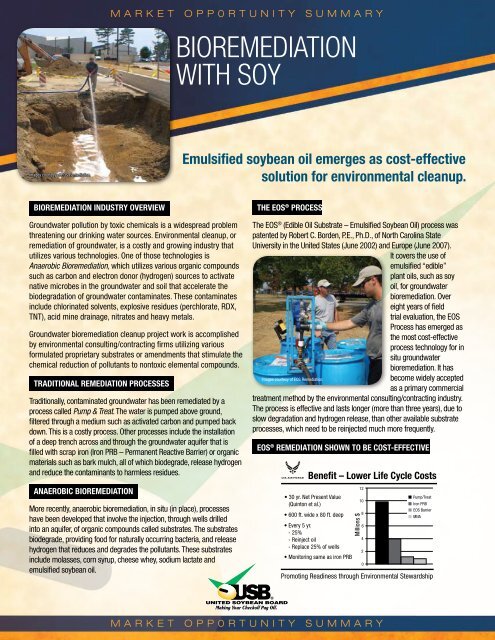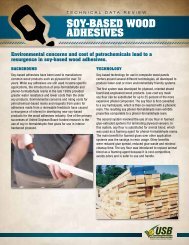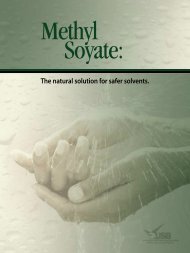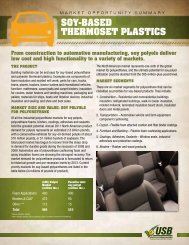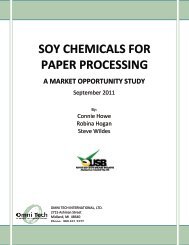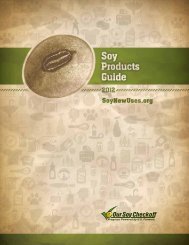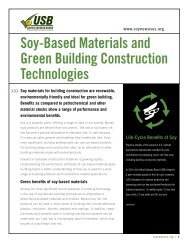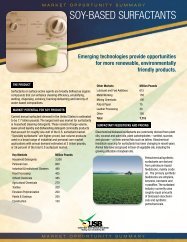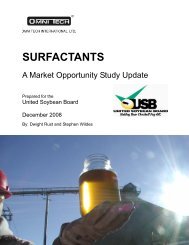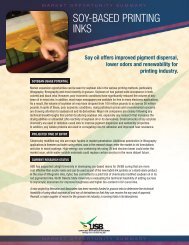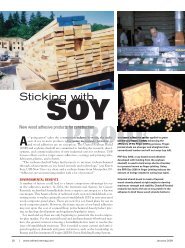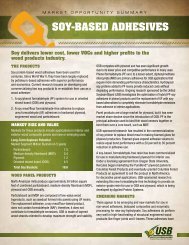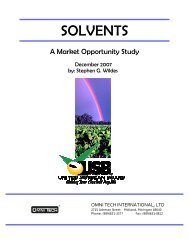BIOREMEDIATION WITH SOY - Soy New Uses
BIOREMEDIATION WITH SOY - Soy New Uses
BIOREMEDIATION WITH SOY - Soy New Uses
Create successful ePaper yourself
Turn your PDF publications into a flip-book with our unique Google optimized e-Paper software.
MARKET OPP0RTUNITY SUMMARY<br />
<strong>BIOREMEDIATION</strong><br />
<strong>WITH</strong> <strong>SOY</strong><br />
Images courtesy of EOS Remediation.<br />
Emulsified soybean oil emerges as cost-effective<br />
solution for environmental cleanup.<br />
Bioremediation Industry Overview<br />
The EOS ® Process<br />
Groundwater pollution by toxic chemicals is a widespread problem<br />
threatening our drinking water sources. Environmental cleanup, or<br />
remediation of groundwater, is a costly and growing industry that<br />
utilizes various technologies. One of those technologies is<br />
Anaerobic Bioremediation, which utilizes various organic compounds<br />
such as carbon and electron donor (hydrogen) sources to activate<br />
native microbes in the groundwater and soil that accelerate the<br />
biodegradation of groundwater contaminates. These contaminates<br />
include chlorinated solvents, explosive residues (perchlorate, RDX,<br />
TNT), acid mine drainage, nitrates and heavy metals.<br />
Groundwater bioremediation cleanup project work is accomplished<br />
by environmental consulting/contracting firms utilizing various<br />
formulated proprietary substrates or amendments that stimulate the<br />
chemical reduction of pollutants to nontoxic elemental compounds.<br />
Traditional remediation processes<br />
Traditionally, contaminated groundwater has been remediated by a<br />
process called Pump & Treat. The water is pumped above ground,<br />
filtered through a medium such as activated carbon and pumped back<br />
down. This is a costly process. Other processes include the installation<br />
of a deep trench across and through the groundwater aquifer that is<br />
filled with scrap iron (Iron PRB – Permanent Reactive Barrier) or organic<br />
materials such as bark mulch, all of which biodegrade, release hydrogen<br />
and reduce the contaminants to harmless residues.<br />
Anaerobic Bioremediation<br />
More recently, anaerobic bioremediation, in situ (in place), processes<br />
have been developed that involve the injection, through wells drilled<br />
into an aquifer, of organic compounds called substrates. The substrates<br />
biodegrade, providing food for naturally occurring bacteria, and release<br />
hydrogen that reduces and degrades the pollutants. These substrates<br />
include molasses, corn syrup, cheese whey, sodium lactate and<br />
emulsified soybean oil.<br />
The EOS ® (Edible Oil Substrate – Emulsified <strong>Soy</strong>bean Oil) process was<br />
patented by Robert C. Borden, P.E., Ph.D., of North Carolina State<br />
University in the United States (June 2002) and Europe (June 2007).<br />
It covers the use of<br />
emulsified “edible”<br />
plant oils, such as soy<br />
oil, for groundwater<br />
bioremediation. Over<br />
eight years of field<br />
trial evaluation, the EOS<br />
Process has emerged as<br />
the most cost-effective<br />
process technology for in<br />
situ groundwater<br />
bioremediation. It has<br />
Images courtesy of EOS Remediation.<br />
become widely accepted<br />
as a primary commercial<br />
treatment method by the environmental consulting/contracting industry.<br />
The process is effective and lasts longer (more than three years), due to<br />
slow degradation and hydrogen release, than other available substrate<br />
processes, which need to be reinjected much more frequently.<br />
EOS ® remediation shown to be cost-effective<br />
Benefit – Lower Life Cycle Costs<br />
• 30 yr. Net Present Value<br />
(Quinton et al.)<br />
• 600 ft. wide x 80 ft. deep<br />
• Every 5 yr.<br />
- 25%<br />
- Reinject oil<br />
- Replace 25% of wells<br />
• Monitoring same as iron PRB<br />
Millions $<br />
Promoting Readiness through Environmental Stewardship<br />
12<br />
10<br />
8<br />
6<br />
4<br />
2<br />
0<br />
Pump/Treat<br />
Iron PRB<br />
EOS Barrier<br />
MNA<br />
MARKET OPP0RTUNITY SUMMARY
MARKET OPP0RTUNITY SUMMARY<br />
<strong>BIOREMEDIATION</strong> <strong>WITH</strong> <strong>SOY</strong><br />
Market Potential – <strong>Soy</strong>-Based Bioremediation Products<br />
The bioremediation market is difficult to define because discovery<br />
of contaminated sites is ongoing and securing funding to remediate<br />
them is a priority. The use of soybean-oil-based bioremediation<br />
products and processes is a treatment alternative that is becoming<br />
a well-accepted industry standard process technology.<br />
There are some unrelated data sources that do provide some idea<br />
of the magnitude of the market potential for soy products.<br />
Hazardous Waste Sites<br />
The Department of Energy (DOE) estimates it would cost $150<br />
billion to restore thousands of identified sites contaminated with<br />
chlorinated solvents, perchlorates, explosives, metals and nuclear<br />
waste. One such site, the Pantex munitions depot near Amarillo,<br />
Texas, is currently being remediated with soybean emulsion process<br />
technology that is estimated to potentially use 2 million pounds of<br />
soy oil emulsion product per year for 30 years. The Department of<br />
Defense (DOD) has reportedly budgeted about $4 billion to clean up<br />
military bases.<br />
Mining – Acid Mine Drainage (AMD)<br />
There are up to 500,000 abandoned mines in the United States,<br />
many with acid groundwater problems. Fifty of those are superfund<br />
sites that could cost millions per site to restore.<br />
Market Demand for <strong>Soy</strong><br />
One supplier of soy oil emulsion products estimates the current<br />
U.S. bioremediation market to be about 1 billion dollars per year.<br />
<strong>Soy</strong>-oil-based products are being used on 200-300 cleanup sites<br />
as EOS ® , EVO (Emulsified Vegetable Oil) or straight soy oil.<br />
Current annual soy oil use for bioremediation is in excess of<br />
5 million pounds and growing. The use of EVO processes is<br />
expanding internationally as well in Japan, Europe, Australia<br />
and South America.<br />
<strong>Soy</strong>-Based Bioremediation Product Suppliers<br />
EVO is a generic term used by the industry for emulsified soybean<br />
oil, since EOS ® is a trade name of EOS ® Remediation, the licensee<br />
that supplies the emulsion. There are currently six suppliers of soy<br />
oil products for the groundwater bioremediation market:<br />
• EOS ® Remediation – “EOS ® ” products, series of soybean oil<br />
formulated emulsion products<br />
• RNAS (Remediation and Natural Attenuation Services) –<br />
“<strong>New</strong>man Zone” EVO products, soybean oil emulsions<br />
• Terra Systems – “SRS” (Slow Release Substrate) products,<br />
soybean oil emulsions<br />
• Carus Corp. – “CAP18,” straight soybean oil and “CAP18-ME” –<br />
soy oil with 10% SME (soy methyl ester)<br />
• Regenesis – “3DMe” Microemulsion with soybean oil<br />
C-18 fatty acids<br />
• JRW Bioremediation – “LactOil” – <strong>Soy</strong>bean oil (45 percent) and<br />
ethyl lactate (35 percent) emulsions and concentrates<br />
These companies sell soy-oil-based products to environmental<br />
consulting/contractors who bid for and do the site remediation<br />
work, which often takes five to 10 years to complete.<br />
ABOUT USB<br />
USB is made up of 68 U.S. farmer-directors who oversee the<br />
investments of the soybean checkoff, a U.S. soybean research<br />
and promotion program, on behalf of all U.S. soybean farmers.<br />
Checkoff funds are invested in the areas of animal utilization,<br />
human utilization, industrial utilization, industry relations, market<br />
access and supply. As stipulated in the <strong>Soy</strong>bean Promotion,<br />
Research and Consumer Information Act, USDA’s Agricultural<br />
Marketing Service has oversight responsibilities for USB and the<br />
soybean checkoff.<br />
For more information, visit: soynewuses.org<br />
©2010 United <strong>Soy</strong>bean Board [38508-MOSB-3/10]<br />
MARKET OPP0RTUNITY SUMMARY


